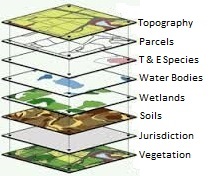
Landscape conservation plans and conservation priority maps or "greenprints" (PDF) demand the best available science and data on ecosystems, natural communities, and species. Of key importance is data in a spatially-explicit format, produced in Geographic Information Systems (GIS) as individual data layers that can be combined and communicated as maps for decision-making.
This page is intended as a guide to the correct use and availability of some of the major GIS data layers and decision support tools for large-scale conservation planning both within California and in the Western United States. Also included here are descriptions of non-spatial data sets for conservation planning.